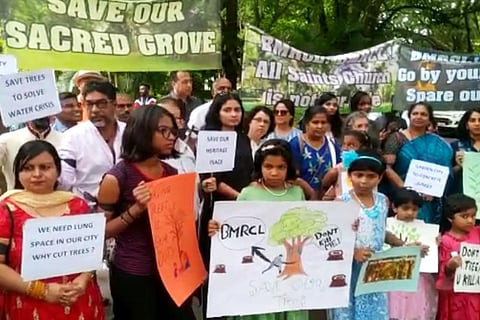

After years of battle against the Karnataka Industrial Area Development Board, parishioners of the All Saints’ Church in Bengaluru say they can rest easy, as their church is safe from the construction of the Bengaluru metro station proposed to be built inside the church premises. As per the plan of the Karnataka industrial board, the upcoming Vellara Junction metro station was proposed to come up under the church premises, for which the industrial development body had begun acquiring land around the church in 2018. Around 100 heritage trees in the premises of the church faced the danger of being cut down. Now, in a partial win for the parishioners, the Bangalore Metro Rail Corporation Limited (BMRCL) has agreed that only a portion of the church land will be acquired.
In a statement, the All Saints Church Congregation Welfare Association and the Environment Support Group, the metro will acquire only 166 square metres of the land, as opposed to the earlier 4582 square metres proposed to be acquired. The metro will also acquire an additional 218 sq m of land, but only temporarily. Moreover, only 7 trees would be felled or relocated, as against over 100 heritage trees that would have been destroyed. An agreement to this effect was signed in January 2022, the statement said.
This is a big win for the environmentalists and church goers who have been staging protests against the proposed land takeover for the past five years. Since 2018, parishioners have been staging protests every Sunday, as the proposed metro station would destroy the heritage trees — their ‘sacred grove’ — that were planted by the church’s founders more than 150 years ago. “The sacred grove of the church, abutting the church, was where an underground station of Namma Metro was proposed. This meant at least 100 heritage trees that created a most extraordinarily beautiful sacred grove of the church, would have been felled. Along with this destruction would have destroyed generations of memories and the divinity of the space,” a statement by the All Saints Church issued on Monday, May 2, said.
“This space, like tens of other such religious and spiritual places of Bengaluru, are representative of the syncretic tradition that is core to the metropolis’ culture. Surely, for planners of the Bengaluru Metro, it would have seemed improbable to ruin this rare and sylvan space in a city so completely filled with buildings, roads and traffic,” the statement added.
Watch: Why activists and churchgoers are protesting Bengaluru metro expansion
The issue began when the project report showed that the proposed metro station for the metro line from Bannerghatta road to Nagwara would be inside the campus, and the All Saints Church congregation as well as environmentalists had opposed this plan vehemently. While the Detailed Project Report for Phase 2 of the erstwhile Bangalore Metro, was brought out in June 2011, did not mention the church or its property at all, the metro decided to change the alignment in during land acquisition, which sparked off the protests in June 2018.
Though the church building itself will not have gotten affected, members of the church had said that the underground digging would affect the building, and affect religious activities being conducted in the church.
However, after the issue was reported by TNM in 2020, the BMRCL had responded saying that the metro would not pass under the church, as the alignment on Hosur Road was 36 metres from the building. "Width of church premises along Hosur road is around 90m whereas width of land required for metro construction is only 38m, thereby leaving sufficient width along the Hosur road. Thus the main approach to the church from Hosur road remains intact even during metro construction", the BMRCL statement had said.
The protests against the metro station continued till December 2021, after which Anjum Pervez, who took over as MD of BMRCL in 2021, met with the protesters and the representatives of the environment groups to consider the possibility of saving the sacred grove, and also protecting the church from adverse impacts of the metro construction. After many conversations and deliberations, this solution was arrived at.
“This is a story of a win win for all: religious sacred spaces saved for posterity, BMRCL can get on with the construction of the station, Special Children will not be dislocated, the Church will be protected (BMRCL has also supported studies by INTACH to protect its structural integrity), and the metropolis will be proud to claim a distinctive save of a historical, reverential, living heritage. Future generations will be grateful for these collective efforts,” the statement by the church members and environmentalists said.